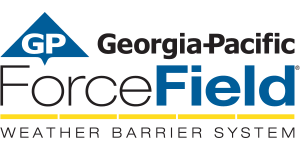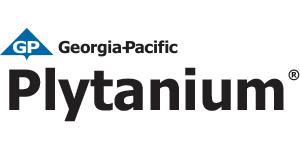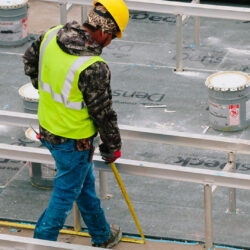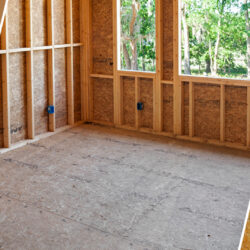Buildings account for about 40% of the total energy consumed in the United States. That’s more energy than both the industrial and transportation sectors consume, according to the U.S. Green Building Council.[1]
Recognizing the growing need to conserve energy, modern building codes have adapted to require continuous insulation, an efficient solution for keeping buildings warm in the winter and cool in the summer. Continuous insulation consists of a single layer of insulation over the studs without any breaks, or thermal bridges, other than fasteners or service openings. Thermal bridges are gaps in the building’s insulation layer that allow heat to escape. These thermal bridges can account for heat loss of up to 30%.[2]
To understand how continuous insulation works, it helps to think of a building like a human body, explains John Chamberlin, senior product manager for the DensElement® Barrier System. “Continuous insulation is essentially a big coat that you wrap around your building,” he says.
If you’re standing outside without clothes in the middle of winter, you’re going to get cold. Your body expends energy trying to warm up. Wearing a coat will help you stay warm, but you won’t be as warm if you don’t have the coat zipped.
In the same way, buildings consume large amounts of energy to stay warm when it’s cold outside, or cool when it’s hot outside. Insulation will keep the building warm, but the insulation needs to be one continuous layer to meet the American Society of Heating, Refrigeration and Air Conditioning Engineers (ASHRAE) 90.1 code according to the International Energy Construction Code (IECC).
Traditionally, buildings with steel-framed construction have used fiberglass-batt insulation to fill the stud cavities. But the steel studs themselves can cause energy loss and heat movement. “Installing insulation only in the cavity is not enough anymore,” Chamberlin explains.
Continuous insulation may be installed instead of or in addition to traditional insulation and can be placed across different locations of a wall assembly — as long as it consists of a single, continuous layer of insulation, such as rigid foam.
In buildings with metal framing, the metal acts as a conductor for energy, such as heat or cold. If you are warming up the inside of a building during the winter, a portion of that heat moves through the metal framing and then escapes. “Running the furnace is meant to heat the inside of the building, but a portion of that energy is wasted because the heat goes through the metal components and to the exterior of the building,” Chamberlin says.
Continuous insulation reduces that movement of heat. Insulating the building’s exterior prevents the heat from moving outside the building. “It’s held within the building, and therefore you’re not just pouring the energy unnecessarily to the outside,” Chamberlin says.
Energy codes evolve
The requirement for continuous insulation was first put in place by ASHRAE and is part of ASHRAE Standard 90.1, the U.S. energy standard for commercial buildings. ASHRAE developed the standard in the 1970s in response to the U.S. energy crisis.
Usage of continuous insulation has picked up significantly since 2012, after the U.S. Department of Energy sponsored changes to the International Energy Conservation Code calling for a 30% increase in building energy savings — the single-largest energy efficiency increase in the history of the energy code. Continuous insulation requirements were among those changes.[3]
There are several different strategies and products for achieving continuous insulation. Some designers have started saying that insulating the stud cavities is a waste of money, and that all insulation should be on the exterior of the building.
“What you’ll find in commercial buildings throughout the U.S. is usually a combination of fiberglass in the cavities, with continuous insulation on the exterior,” Chamberlin says. Or, spray foam may be used on the interior, and rigid foam for continuous insulation on the exterior.
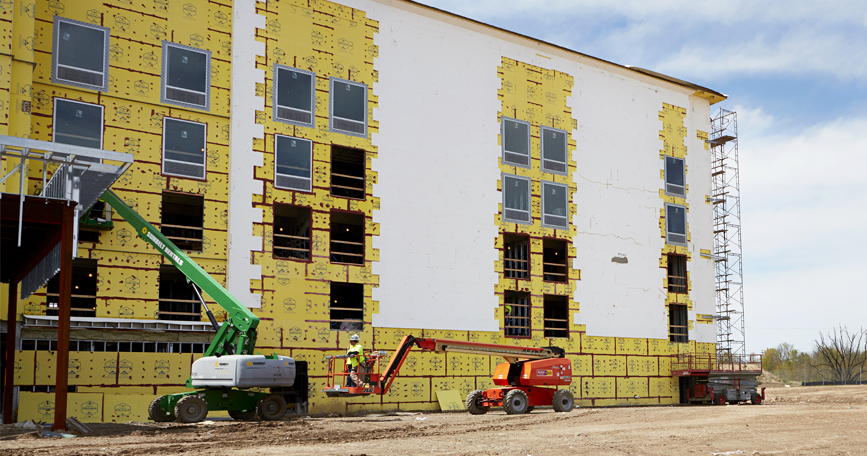
Meeting fire criteria
One concern with the increased use of continuous insulation is how to meet the building code requirements related to fire. Modern code requires continuous insulation, but adding insulation to a building’s exterior often introduces a combustible component to the building envelope.
High-rise fires such as the Grenfell Tower fire in London and the blaze that engulfed a 15-story building in Mumbai have made headlines in recent years, drawing attention to combustible cladding’s and exterior insulation.
Building designers are tasked with not only having to figure out how to get their project’s continuous insulation to meet code, but also how to construct the building in a way that is not adding a hazardous element. “Mineral wool insulation presents an excellent option for continuous insulation because it isn’t combustible,” Chamberlin says. Mineral wool contains flame retardant chemicals that make it highly fireproof. It also offers sound control benefits because of its density. Combustible insulations like EPS, XPS, and Polyiso may also be good choices for continuous insulation if they are included in assemblies that pass NFPA 285.”
Designers must then figure out what kind of water-resistive barrier (WRB) to use with that insulation to minimize fire risks, given that most WRBs have some level of combustibility. DensElement® Barrier System offers a non-combustible solution for the exterior sheathing, air barrier and water-resistive barrier. “Most other WRBs are combustible that will work well in these wall assemblies, but those WRBs must be included in assemblies that pass NFPA 285 to address concerns about fire. DensElement is not because it’s made from gypsum,” Chamberlin says.
Per, the 2018 International Building Code, DensElement Barrier System is exempt from NFPA 285, the National Fire Protection Agency standard test method for evaluation of fire propagation characteristics of exterior wall assemblies containing combustible components. So in an assembly in which the WRB is the combustible component, DensElement Barrier System would be a suitable non-combustible WRB replacement.“ “Compared to wall assemblies with combustible WRB components, DensElement® Barrier System is a much simpler way to meet fire codes,” Chamberlin says.
Pairing DensElement® Barrier System with non-combustible continuous insulation empowers designers to create a building that meets standards for a more energy-efficient, fire-safe structure.
[1] https://www.usgbc.org/articles/green-building-facts
[2] https://www.echotape.com/blog/continuous-insulation-care/
[3] https://www.constructionspecifier.com/continuing-education-on-continuous-insulation/
This article is intended solely as general information. Ultimately, the design and detailing of any project, assembly or system is the responsibility of a professional, and all projects must comply with applicable building codes and standards. For information concerning the limited warranty for the DensElement® Barrier System, visit www.denselement.com. GP Gypsum disclaims any responsibility or liability for the architecture, design, engineering or workmanship of any project, assembly or system.


